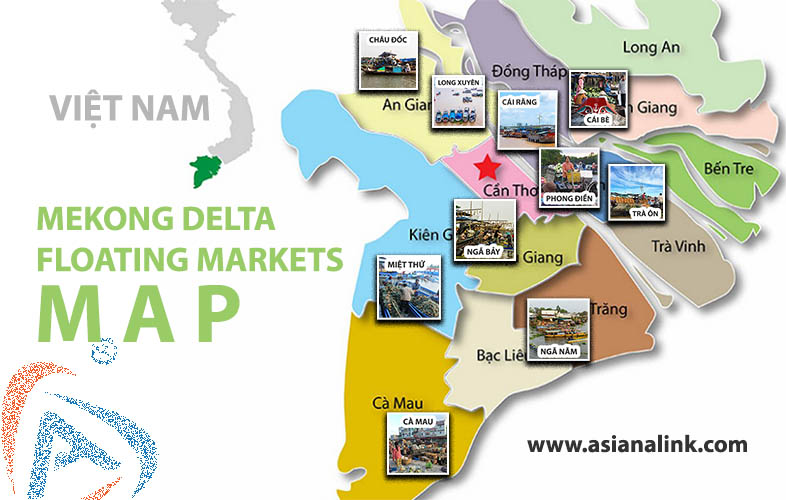
- On 5 August, 2020
- In ALL BLOGS VIỆT NAM BLOGS
- Tags Tags: angiang, caibe, camau, chaudoc, floatingmarket, longxuyen, tiengiang, vinhlong
10 TOP-RATED FLOATING MARKETS IN MEKONG DELTA, VIỆT NAM!
Floating markets have become a way of life and trade for Mekong Delta dwellers for over 100 years, thanks to the complex and extensive river system of the region. Here we list the top floating markets worth a visit. They are a major part of the locals’ traditional economy, and offer you genuine local experiences. The markets below are located at accessible places, making it optional for you to visit and then continue your journey by exploring nearby islands.
Bear in mind that the dry season between October and April might be the best time to visit, to avoid seasonal floods and to enjoy the best weather.
Here are our list of 10 floating markets that you don’t want to miss in Mekong Delta.
- Cái Bè Floating Market, Tiền Giang Province
- Trà Ôn Floating Market, Vĩnh Long Province
- Cái Răng Floating Market, Cần Thơ City
- Phong Điền Floating Market, Cần Thơ City
- Long Xuyên Floating Market, An Giang Province
- Châu Đốc Floating Market, An Giang Province
- Ngã Năm Floating Market, Sóc Trăng Province
- Ngã Bảy Floating Market, Hậu Giang Province
- Cà Mau Floating Market, Cà Mau Province
- Miệt Thứ Floating Market, Kiên Giang Province
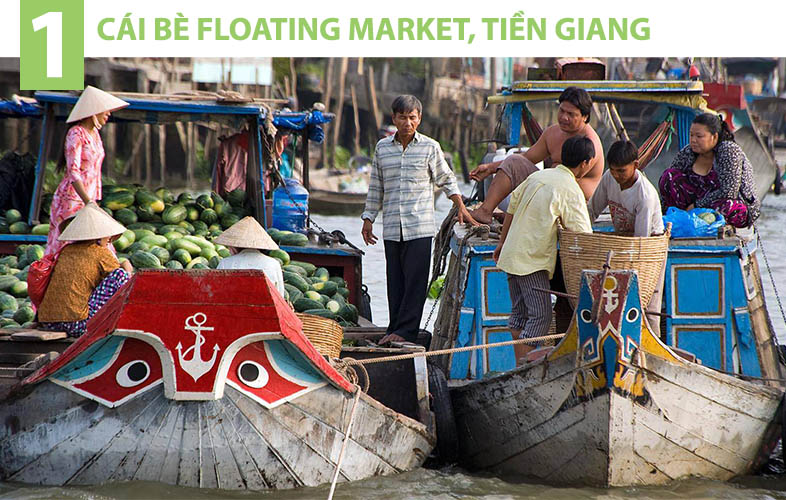
Cái Bè floating market is located in Cái Bè district, Tiền Giang Province, on the vast Tiền River, bordering three provinces of Tiền Giang, Vĩnh Long and Bến Tre. The market is a place to buy and sell goods, as a transit station for fruits and produce throughout the region and also an important attraction of Tiền Giang province.
Unlike normal floating markets that only meet in the morning, Cái Bè floating market starts trading from dawn until late at night. However, it is no longer a crowded floating market as before. Today, the number of boats anchored in the center of the floating market has decreased compared to the past. The main reason is that the road system has been developed, so the number of boats operating on Cái Bè floating market has decreased rapidly, only a few dozen boats wholesale fruit, vegetables and tubers…
The biggest advantage of Cái Bè floating market is its convenient location, only 2.5 hours drive from Hồ Chí Minh City, so most visitors who want to visit the floating market can still make it as a day trip.

Trà Ôn floating market is located in Trà Ôn District, Vĩnh Long Province. This is one of the features that bring about the typical culture of the Southwest region. From a long time, the floating market of Trà Ôn in people’s minds has become a long-standing floating market and associated with many cultural activities of people in the area.
And similar to many other ones, Trà Ôn Floating Market is not “static” like the normal markets offshore but always “moving” because both the sellers and the buyers have to move by boat: mobile shops, mobile house, and mobile goods also, etc. Everything is mobile.
The most popular goods traded in the floating market are fruits. They are so many that all the fruits on the boats seem to cover the surface of the river with their brilliant colors. In the floating market, people can easily purchase and taste different kinds of fruits that are typical for the Mekong Delta cuisine, from popular ones such as bananas, guavas, tangerines, oranges, etc. to the luxury ones such as durians, mangosteens, mangoes or grapefruits, etc. In particular, they are all very fresh and delicious, and the sellers on the floating market always sell them at the right price, wherever you come from. Nothing can be better than relaxing and enjoying the fresh fruits in your Mekong Delta cruise.
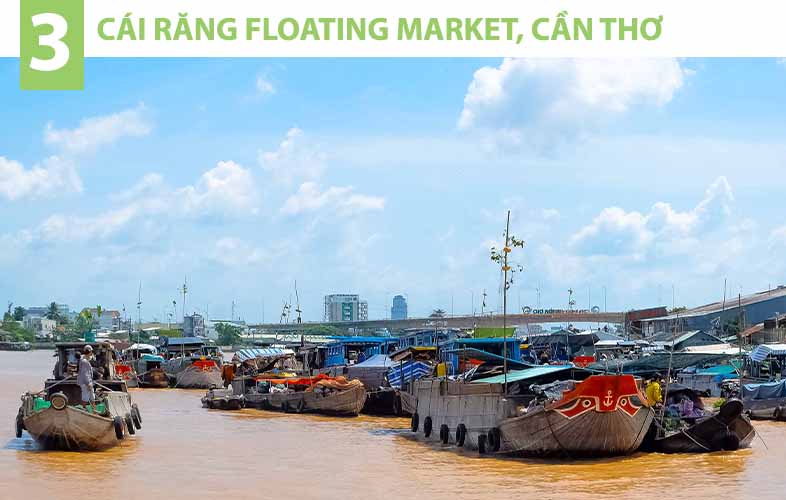
The biggest floating market in the Mekong Delta, Cai Rang is about 6km from Ninh Kiều wharf of Cần Thơ in the direction of Sóc Trăng Province. There’s a bridge here that serves as a great vantage point for photography. The market is best around 6am to 7am, and it’s well worth getting here early to beat the boatloads of tourists and the heat. This is a wholesale market, so look at what’s tied to the long pole above the boat to see what they’re selling.
Most of the boats are loaded with a lot of agricultural products and specialties of Mekong River Delta such as vegetables, coconut, banana, watermelon, grapefruit, and dragon fruit and so on. Small boats which sell drinks and food for breakfast go among the others to serve market-goers and visitors. Other products such as clothes, candy, and medicine… are available here, not different from what are sold in mainland markets.
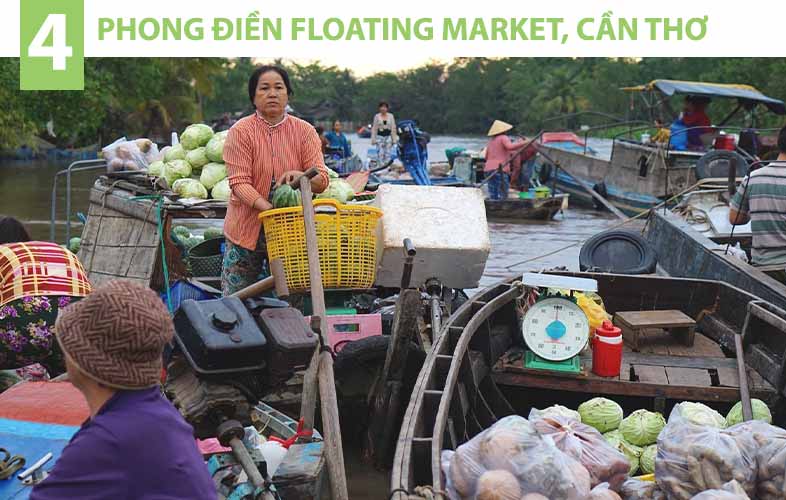
Unlike Cái Răng Floating Market, Phong Điền Floating Market not just sells agricultural products, but also other various ones. In the market, there are boats selling household and working tools such as canoes, boats, roofing sheets, knives, hoes, machete, and fishing tools like fishing nets, or weaving products as baskets, and all kinds of general domestic and foreign cargoes. In addition, the market also sells many types of food: noodle soup, noodle with toasted meat, rice soup, Hủ Tíu noodles, and coffee, etc. In particular, there are dozens of ferry and vessels anchoring at the river’s bank. They are ready to take tourists to visit the floating market. Ship-owners are often the locals, thus they should be able to work as “concierge”.
The floating market usually opens early from dawn. The time period from 7 – 8 am will be seen as the bustling time and remains its trading activities till the afternoon.
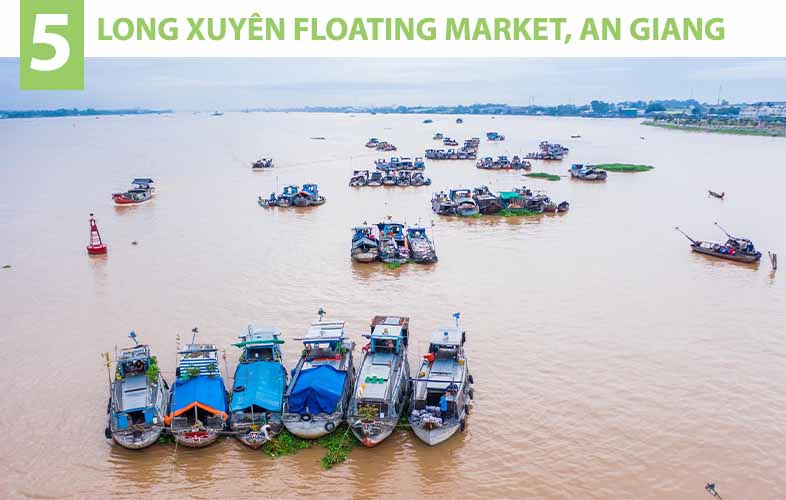
Situated near the Hậu River in the center of Long Xuyên City, the floating market was established several decades ago. Nowadays, transportation in the city has been upgraded, but the market preserves its old trading traditions. The market begins at around 5 a.m.Here, tourists can see the one-of-a-kind trading method of the Mekong Delta: vendors sell goods from boat to boat in agile and decisive movements.
For food lovers, the market is definitely a top spot. On the boats, you can enjoy the exotic cuisine of the south of Việt Nam. In a 2013 cooking television show chef and western TV celebrity Gordon Ramsay referred to a hủ-tíu or Vietnamese special rice noodle he ate on a Vietnamese floating market as one of the best dishes he had ever tasted. The delicious food sold in the floating market is indeed a big attraction of the market itself.

Châu Đốc Floating Market was formed a long time ago. Life of local people here is always “attached” to boats. Boats are their greatest shelters. For the locals, phrase “Châu Đốc Floating Market” is not popular; they are familiar with the beloved word “ra ghe” meaning “come to boats”. Those words stand for activities of exchange and sales at Châu Đốc Floating Market.
The floating market is always full of boats and people. Owners of these boats come from different places in this country. They carry products from other places to here, and then sell them to the locals and tourists. Guests of the floating market come from different places. They buy goods then freight to distant places for reselling.
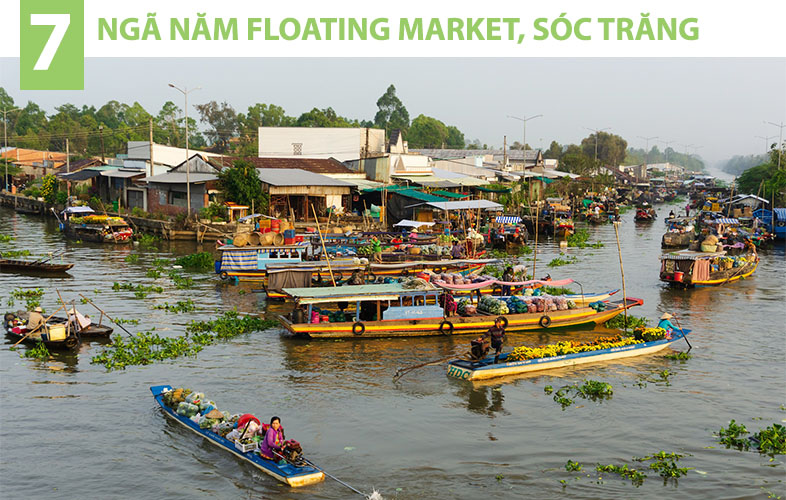
Located about 60 kilometers from Sóc Trăng Town, the Ngã Năm floating market acquires its name from the convergence of five canals – Cà Mau, Vĩnh Quới, Long Mỹ, Thanh Trì and Phụng Hiệp – in Ngã Năm Commune.
With new roads making traveling easier than it was before, businesses here and in other floating markets are dying out and not as crowded as it used to be. Still, boats and traders keep coming to the Ngã Năm floating market till today because it remains a transit point for locals from different provinces that the canals flow through.
A wide variety of goods are traded on the waterways, including vegetables, meat, salt, clothes and even lottery tickets. But fruit is one of the best-selling goods at the Ngã Năm market since watermelon, coconut, banana, pineapple and many other fruits are the delta’s main produce.
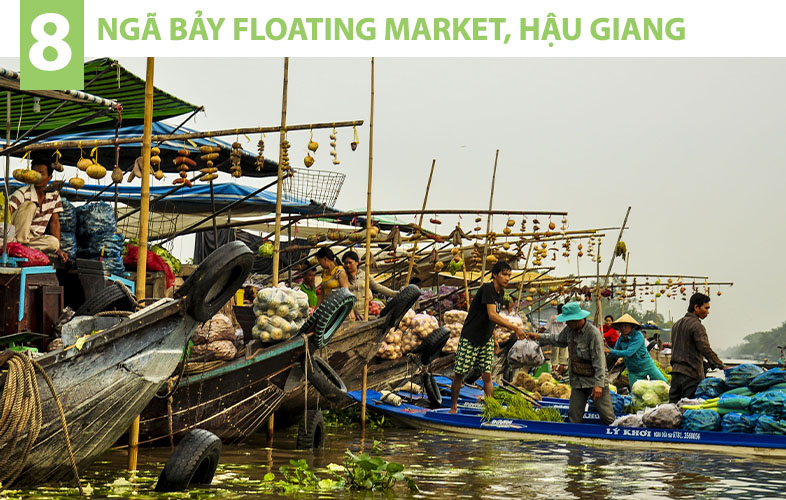
The history of the famous Ngã Bảy Floating Market dates back to the early 1900s, when the French in their intensive efforts to tame the Mekong Delta dug and dredged arteries of canals, tributaries and water grids to create major lines of transportation in the new frontier land. Among those excavation projects was Ngã Bảy, the convergence of seven canals designed by the contractor Sté Francaise Industrielle d’Extrême – Orient and completed in 1908, according to the late Vietnamese writer and historian Sơn Nam.
The once famous hustle and bustle of Ngã Bảy, one of the biggest floating markets in the Mekong Delta, has diminished to a minor gathering place where only a few traders are trying to cling on in the narrow waters of the Bà Ngân Canal.
Before its slow demise, the market was a thriving hub for decades along the maze of canals on the southern side of the Bassac River. Floating upon the confluence of seven canals running from the Delta’s capital, the market stretched for miles, and a whole town prospered from it, growing into a commercial hub in a multi-cultural, multi-ethnic region.
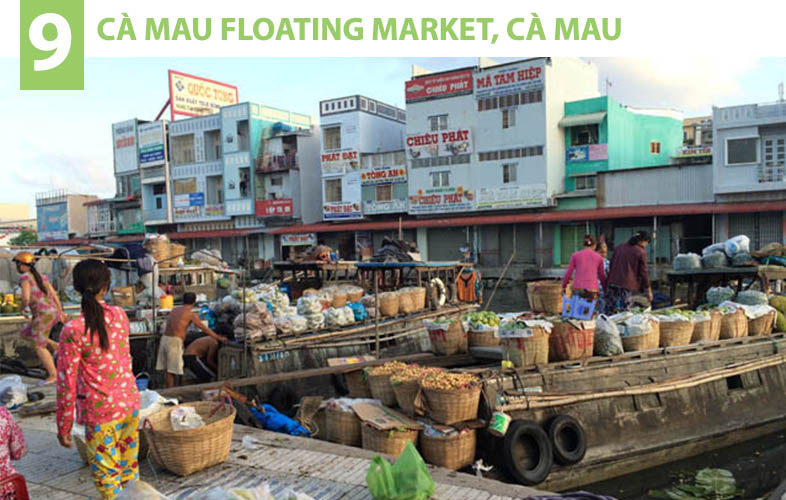
Cà Mau floating market is a perfect glance into local Mekong Delta lifestyle. The market is a one-stop destination for barter and trading of goods in Cà Mau. In the morning, you will see a number of women in motorboats selling piping hot rice cakes and other Vietnamese breakfast items. You will also see young children cuddled up in boats and covered in mosquito nets, sleeping. You might also find a number of motorboats cruising through the river.
It will be an exciting experience when you leisurely cruise through waterways to observe floating stalls and buy what you want. Many people prefer getting something as a gift for their families and friends. It’s always worth enabling you to understand about the locals’ daily life by a visit to the market.
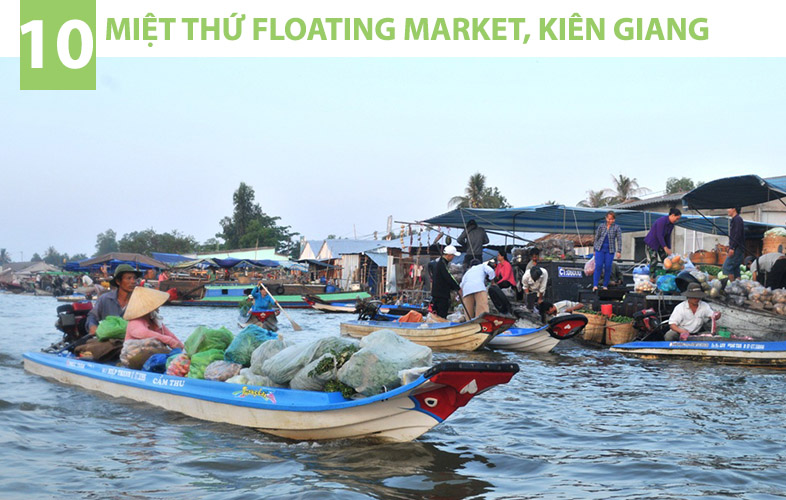
Miệt Thứ Floating Market is located on the Vĩnh Thuận River, in Vĩnh Thuận District, Kiên Giang Province. The floating market starts around 4 a.m. and ends around 6 p.m. daily. The market time frame is the busiest in the day from 4 – 7a.m. and from 3 – 5p.m. In these hours, there are thousands of boats and canoes getting together.
This market is not as big as Cái Răng floating market in Cần Thơ. However, there is a very harmonious arrangement, specifically for the big boats, all boats are parked close to the edge of Vĩnh Phước 2 Quarter. The remaining small vehicles can easily move around, sometimes 3-4 boats can trade in the middle of the river, but most of them are anchored in Vĩnh Đông 2 neighborhood.